
Alaskan brown bear catching a jumping salmon, Brooks Falls.
Species: Brown bear, Ursus arctos
Location: Brooks River, Katmai National Park, Alaska
Image ID: 17031
Species: Brown bear, Ursus arctos
Location: Brooks River, Katmai National Park, Alaska
Image ID: 17031
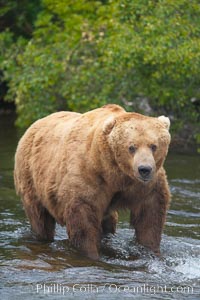
A large, old brown bear (grizzly bear) wades across Brooks River. Coastal and near-coastal brown bears in Alaska can live to 25 years of age, weigh up to 1400 lbs and stand over 9 feet tall.
Species: Brown bear, Ursus arctos
Location: Brooks River, Katmai National Park, Alaska
Image ID: 17039
Species: Brown bear, Ursus arctos
Location: Brooks River, Katmai National Park, Alaska
Image ID: 17039
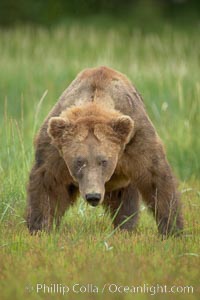
Full grown, mature male coastal brown bear boar (grizzly bear) in sedge grass meadows.
Species: Brown bear, Ursus arctos
Location: Lake Clark National Park, Alaska
Image ID: 19134
Species: Brown bear, Ursus arctos
Location: Lake Clark National Park, Alaska
Image ID: 19134
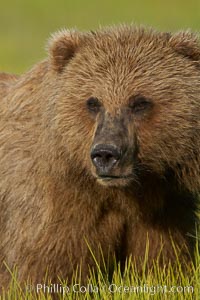
Portrait of a young brown bear, pausing while grazing in tall sedge grass. Brown bears can consume 30 lbs of sedge grass daily, waiting weeks until spawning salmon fill the rivers.
Species: Brown bear, Ursus arctos
Location: Lake Clark National Park, Alaska
Image ID: 19135
Species: Brown bear, Ursus arctos
Location: Lake Clark National Park, Alaska
Image ID: 19135

Brown Pelicans gather in large numbers on coastal cliffs, Goldfish Point near the Clam in La Jolla. Aerial photograph.
Species: Brown Pelican, Pelecanus occidentalis, Pelecanus occidentalis californicus
Location: La Jolla, California
Image ID: 37954
Species: Brown Pelican, Pelecanus occidentalis, Pelecanus occidentalis californicus
Location: La Jolla, California
Image ID: 37954

Giant redwood, Lady Bird Johnson Grove, Redwood National Park. The coastal redwood, or simply 'redwood', is the tallest tree on Earth, reaching a height of 379' and living 3500 years or more. It is native to coastal California and the southwestern corner of Oregon within the United States, but most concentrated in Redwood National and State Parks in Northern California, found close to the coast where moisture and soil conditions can support its unique size and growth requirements.
Species: California redwood, Coast redwood, Giant redwood, Sequoia sempervirens
Location: Redwood National Park, California
Image ID: 25795
Species: California redwood, Coast redwood, Giant redwood, Sequoia sempervirens
Location: Redwood National Park, California
Image ID: 25795

Two mature brown bears fight to establish hierarchy and fishing rights.
Species: Brown bear, Ursus arctos
Location: Brooks River, Katmai National Park, Alaska
Image ID: 17036
Species: Brown bear, Ursus arctos
Location: Brooks River, Katmai National Park, Alaska
Image ID: 17036

Brown bear waits for salmon at Brooks Falls. Blurring of the water is caused by a long shutter speed. Brooks River.
Species: Brown bear, Ursus arctos
Location: Brooks River, Katmai National Park, Alaska
Image ID: 17047
Species: Brown bear, Ursus arctos
Location: Brooks River, Katmai National Park, Alaska
Image ID: 17047

Brown bear walks on tide flats. Grizzly bear.
Species: Brown bear, Ursus arctos
Location: Lake Clark National Park, Alaska
Image ID: 19136
Species: Brown bear, Ursus arctos
Location: Lake Clark National Park, Alaska
Image ID: 19136

Juvenile female coastal brown bear (grizzly bear) grazes on sedge grass.
Species: Brown bear, Ursus arctos
Location: Lake Clark National Park, Alaska
Image ID: 19137
Species: Brown bear, Ursus arctos
Location: Lake Clark National Park, Alaska
Image ID: 19137

Coastal brown bear in meadow. The tall sedge grasses in this coastal meadow are a food source for brown bears, who may eat 30 lbs of it each day during summer while waiting for their preferred food, salmon, to arrive in the nearby rivers.
Species: Brown bear, Ursus arctos
Location: Lake Clark National Park, Alaska
Image ID: 19138
Species: Brown bear, Ursus arctos
Location: Lake Clark National Park, Alaska
Image ID: 19138

A brown bear mother (sow) stands in tall sedge grass to look for other approaching bears that may be a threat to her cubs.
Species: Brown bear, Ursus arctos
Location: Lake Clark National Park, Alaska
Image ID: 19139
Species: Brown bear, Ursus arctos
Location: Lake Clark National Park, Alaska
Image ID: 19139
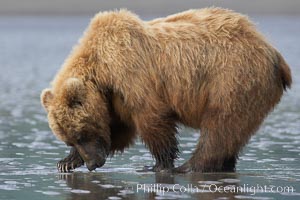
Coastal brown bear forages for razor clams in sand flats at extreme low tide. Grizzly bear.
Species: Brown bear, Ursus arctos
Location: Lake Clark National Park, Alaska
Image ID: 19140
Species: Brown bear, Ursus arctos
Location: Lake Clark National Park, Alaska
Image ID: 19140

Juvenile female brown bear forages for razor clams in sand flats at extreme low tide. Grizzly bear.
Species: Brown bear, Ursus arctos
Location: Lake Clark National Park, Alaska
Image ID: 19141
Species: Brown bear, Ursus arctos
Location: Lake Clark National Park, Alaska
Image ID: 19141

Coastal brown bear on sand flats at low tide.
Species: Brown bear, Ursus arctos
Location: Lake Clark National Park, Alaska
Image ID: 19142
Species: Brown bear, Ursus arctos
Location: Lake Clark National Park, Alaska
Image ID: 19142

Young brown bear stands in tall sedge grass to get a better view of other approaching bears.
Species: Brown bear, Ursus arctos
Location: Lake Clark National Park, Alaska
Image ID: 19143
Species: Brown bear, Ursus arctos
Location: Lake Clark National Park, Alaska
Image ID: 19143

Coastal brown bear walking on sand beach.
Species: Brown bear, Ursus arctos
Location: Lake Clark National Park, Alaska
Image ID: 19144
Species: Brown bear, Ursus arctos
Location: Lake Clark National Park, Alaska
Image ID: 19144
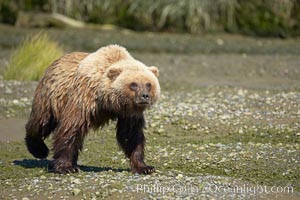
Coastal brown bear walks in Silver Salmon Creek.
Species: Brown bear, Ursus arctos
Location: Silver Salmon Creek, Lake Clark National Park, Alaska
Image ID: 19146
Species: Brown bear, Ursus arctos
Location: Silver Salmon Creek, Lake Clark National Park, Alaska
Image ID: 19146

Young brown bear grazes in tall sedge grass. Brown bears can consume 30 lbs of sedge grass daily, waiting weeks until spawning salmon fill the rivers.
Species: Brown bear, Ursus arctos
Location: Lake Clark National Park, Alaska
Image ID: 19147
Species: Brown bear, Ursus arctos
Location: Lake Clark National Park, Alaska
Image ID: 19147

Brown bears fighting or sparring. These are likely young but sexually mature males that are simply mock fighting for practice.
Species: Brown bear, Ursus arctos
Location: Lake Clark National Park, Alaska
Image ID: 19148
Species: Brown bear, Ursus arctos
Location: Lake Clark National Park, Alaska
Image ID: 19148

Mature male coastal brown bear boar waits on the tide flats at the mouth of Silver Salmon Creek for salmon to arrive. Grizzly bear.
Species: Brown bear, Ursus arctos
Location: Lake Clark National Park, Alaska
Image ID: 19149
Species: Brown bear, Ursus arctos
Location: Lake Clark National Park, Alaska
Image ID: 19149

Brown bear cubs. These cubs are one and a half years old and have yet to leave their mother. They will be on their own and have to fend for themselves next summer.
Species: Brown bear, Ursus arctos
Location: Lake Clark National Park, Alaska
Image ID: 19150
Species: Brown bear, Ursus arctos
Location: Lake Clark National Park, Alaska
Image ID: 19150

Full grown, mature male coastal brown bear boar (grizzly bear) in sedge grass meadows.
Species: Brown bear, Ursus arctos
Location: Lake Clark National Park, Alaska
Image ID: 19151
Species: Brown bear, Ursus arctos
Location: Lake Clark National Park, Alaska
Image ID: 19151

Coastal brown bear forages for razor clams in sand flats at extreme low tide. Grizzly bear.
Species: Brown bear, Ursus arctos
Location: Lake Clark National Park, Alaska
Image ID: 19152
Species: Brown bear, Ursus arctos
Location: Lake Clark National Park, Alaska
Image ID: 19152

A brown bear mother (sow) stands in tall sedge grass to look for other approaching bears that may be a threat to her cubs.
Species: Brown bear, Ursus arctos
Location: Lake Clark National Park, Alaska
Image ID: 19153
Species: Brown bear, Ursus arctos
Location: Lake Clark National Park, Alaska
Image ID: 19153

Brown bear female sow in sedge meadow, with her three spring cubs hidden by the deep grass next to her. These cubs were born earlier in the spring and will remain with their mother for almost two years, relying on her completely for their survival.
Species: Brown bear, Ursus arctos
Location: Lake Clark National Park, Alaska
Image ID: 19154
Species: Brown bear, Ursus arctos
Location: Lake Clark National Park, Alaska
Image ID: 19154

Coastal brown bear in meadow. The tall sedge grasses in this coastal meadow are a food source for brown bears, who may eat 30 lbs of it each day during summer while waiting for their preferred food, salmon, to arrive in the nearby rivers.
Species: Brown bear, Ursus arctos
Location: Lake Clark National Park, Alaska
Image ID: 19155
Species: Brown bear, Ursus arctos
Location: Lake Clark National Park, Alaska
Image ID: 19155

Young brown bear grazes in tall sedge grass. Brown bears can consume 30 lbs of sedge grass daily, waiting weeks until spawning salmon fill the rivers.
Species: Brown bear, Ursus arctos
Location: Lake Clark National Park, Alaska
Image ID: 19156
Species: Brown bear, Ursus arctos
Location: Lake Clark National Park, Alaska
Image ID: 19156

Portrait of a young brown bear, pausing while grazing in tall sedge grass. Brown bears can consume 30 lbs of sedge grass daily, waiting weeks until spawning salmon fill the rivers.
Species: Brown bear, Ursus arctos
Location: Lake Clark National Park, Alaska
Image ID: 19157
Species: Brown bear, Ursus arctos
Location: Lake Clark National Park, Alaska
Image ID: 19157

A brown bear mother (sow) stands in tall sedge grass to look for other approaching bears that may be a threat to her cubs.
Species: Brown bear, Ursus arctos
Location: Lake Clark National Park, Alaska
Image ID: 19158
Species: Brown bear, Ursus arctos
Location: Lake Clark National Park, Alaska
Image ID: 19158